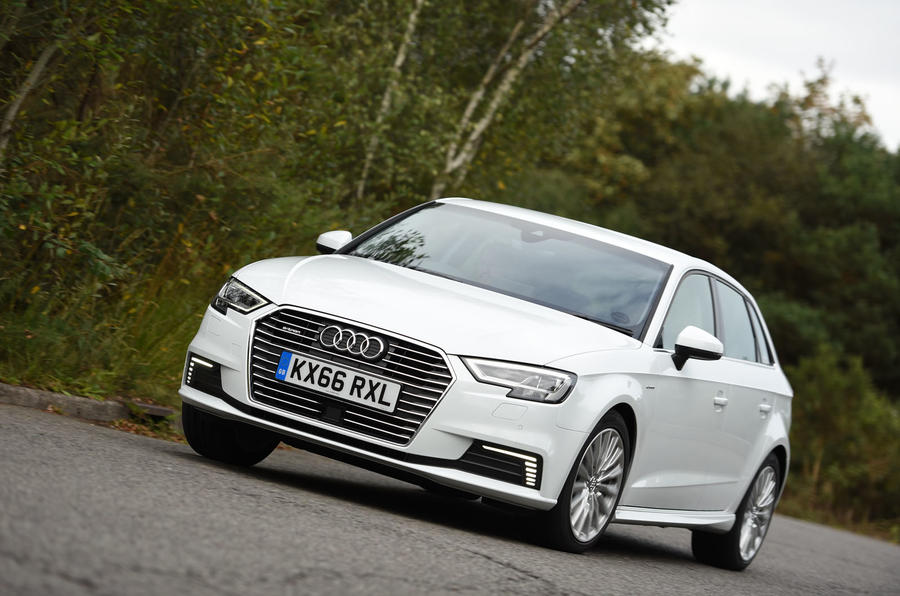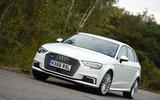What is it?
The Audi A3 Sportback e-tron is the plug-in hybrid offering within the updated Audi A3 range. The entire line-up has had a nip here and a tuck here and here, while this Sportback e-tron model specifically has benefited from an injection of tech on the inside and a tweaked appearance externally, although it remains mechanically unchanged.
That means it still carries a 1.4-litre petrol engine and electric motor in the front, driving through a six-speed dual-clutch automatic transmission, while under the rear seats lives an 8.8kWh lithium ion battery. All that equates to a claimed - and extremely optimistic - official combined consumption figure of 166.2mpg and just 38g/km of CO2 emissions. This will be music to the ears of business buyers hoping to run a plush hatchback with low, tax-friendly monthly bills.
However, as with many hybrid options in the class – the Volkswagen Golf GTE and BMW 330e included – there are some drawbacks to the e-tron. Aside from its higher list price versus mainstream diesel A3s, it also has to lug around the extra weight of its electric motor and battery, which in turn impacts on its dynamic ability. Furthermore, fuel economy is typically never as jaw-dropping as the official figures suggest, and the electric-only range is often more limited, too.
Even so, the e-tron looks to have an enticing blend of performance, economy and practicality. Audi claims a total power output of 201bhp and a 0-62mph time of 7.6sec, which put it in line with the likes of the Volkswagen Golf GTD.
What's it like?
It may look like any other A3 from the outside, but on start-up, the hushed battery soundtrack reveals the e-tron's ultra-green credentials.
The car defaults to EV mode to begin with but remains impressively quiet at most speeds, regardless of which of the three powertrain modes it is running in. Along with EV, there’s also Hybrid mode, which uses a mix of electric and petrol power, and Battery Hold, which reserves the battery's charge for later use by getting the four-cylinder engine to do all the work. They can easily be cycled through via a button on the dashboard and are automatically selected if you run out of electric juice.
You’re unlikely to get particularly close to the claimed 31-mile electric-only range, though. When testing the mechanically identical pre-facelift model, we managed only 18 miles, which means anybody eyeing a no-cost commuting tool will have to measure their route carefully. Likewise, as with every other hybrid, the headline-grabbing combined fuel economy figure will be much lower in the real world. In our experience, expect it to return closer to the 50-60mpg mark at best.
At least the e-tron's small battery ensures that a full charge doesn’t take too long (around two hours from empty, according to Audi), although the e-tron does a pretty good job of replenishing the charge itself. The petrol engine will do this as it runs, while the regenerative brakes also help spool up some electric charge - but this does mean they can be quite grabby, especially at low speeds.
In EV mode, the battery hums away quietly on its own until around 80mph before the engine awakens, while in Hybrid mode it joins in at around 40mph. The transition from electric to petrol and vice versa is pretty seamless, but enthusiastic kickdowns can result in slightly sluggish gear changes. Yet at a cruise, the e-tron offers a very relaxing drive with excellent refinement and a compliant ride that helps it roll nicely over UK roads.






































Join the debate
Add your comment
no mention of BMW 2 Series Active PHEV
It looks even uglier than my 3 series, but it drives well, and the engine sounds sweet when pushed.What I notice here is the recharge cable bag is simply enormous compared to the BMW, surely all the gubbins could be hidden in the bodywork rather than the boot? Perhaps BMW/Audi need to employ a vacuum cleaner designer on detailing?
In the meantime, we should seize the cheap company car tax cars whilst we can before the chancellor hammers us.
How much electricity did it use to cover 18 miles?
Yes DJB is right that it'll run on the 1.4 petrol after battery used up but now it's much heavier than the regualr 1.4 TSI A3!
As for VWgate nonsense - it was VW's fault to try to sell excess Euro 5 engines to the USA and they cheated by using more urea injection under test than on the roads. Latest 2016 UK Govt independent tests show that VW, Audi and BMW have LOWER than Euro 6 emissions in real world driving. So the anti diesel press conveniently ignores it!
New way to cheat